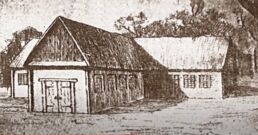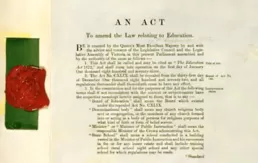THE FIRST ERA
The History of Educationsince 1793
THE FIRST ERA
1793
The history of modern Education in Australia stretches right back to the early colonial days. In 1793, the first chaplain to the Colony of New South Wales, Rev Richard Johnson, along with his wife, Mary, began educating almost 200 students in his newly built church. His tenure was marked with roadblocks and frustration, yet his determined action saw the completion of the church building (largely by his own hands), the education of children from all backgrounds, and intentional welfare programs for many in his community. He provided a bridge of connection between the colonial freeman, convicts, and natives.
Rev Johnson’s school was located on the circular quay end of Castlereagh Street, on the corner of Bligh and Hunter Streets in Sydney, where a monument stands to this day.
That one school birthed a movement. Over the coming decades, free ‘charity schools’ run by other churches and denominations commenced, with education growing predominantly due to the vision and action of the Christian Community.
1814
Prior to white settlement, Indigenous Education was community based, and aboriginal culture was incorporated into daily life from birth to death. The style of this informal education was rich with skill development that was needed for the practical survival of First Nations peoples. Following on from the movement begun by Rev Johnson, Governor Macquarie opened a school for Aboriginal children in 1814, but this was closed by 1820 as the impact of distance and separation upon families was not supported by the indigenous communities.
1816
The oldest school in continuous operation in Australia is Newcastle East Public school, which was founded in 1816. It commenced as a church owned school, known at the time as Christ Church School, and was taught by Henry Wrensford, a convict on conditional pardon. He taught 17 convict children between the ages of 3 and 13 years. The school started in a slab hut near Watt & Bolton Streets when Newcastle’s total population was around 400 people. Over the coming decades, the school’s governance wavered between government and church oversight, finally settling in 1883 as Newcastle East Public School.
1873
Education in Australia had been unfolding for 81 years before the government of the day began to directly intervene in the schooling system. In 1872, Victoria became the first Australian state to pass an Education Act providing for free, secular (in the sense of non-sectarian) public education. The other states gradually came online in the public education sphere over the following 2 decades. These government run public schools grew to dominate the educational landscape with non-government schooling largely limited to poorly funded Catholic parish schools and higher fee denominational schools.
1870-1880
As public education developed across the country, the public funding of non-government schools was terminated by a number of Australian colonies. This heavily impacted the sector. For the next 90 years, independent schools were privately funded.
1892
The First Seventh Day Adventist school in Australia opened in St Kilda, Melbourne in 1892. That movement spread to every state in the nation over the coming century.





